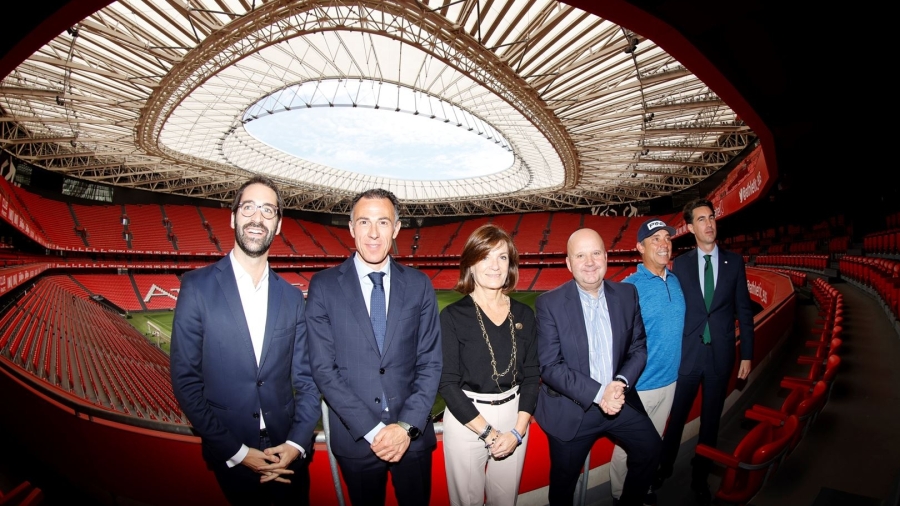
- An EFE Sport Business Days Forum was recently held at San Mamés under the title 'The Football and Sports Tourism Industry in the Basque Country', at which Jaime Blanco of the LaLiga president’s office pointed out that “over the next five years, 40% of LaLiga stadiums will be transformed”.
- Jon Berasategi, the general director of Athletic Club, stated that the project carried out at San Mamés has brought significant economic growth, “generating around 12 million euros extra per year”.
- Amaia Gorostiza, the president of SD Eibar, pointed out that the investment of 20 million euros of the club’s own resources to refurbish Ipurua Stadium has brought “a very notable improvement”.
In Spain, football occupies a special place in society and its importance reaches far beyond the pitch. In fact, the sport is so important for the country as a whole that the socio-economic impact of professional football, made up of LaLiga Santander and LaLiga SmartBank, is 185,000 jobs, 4.1 billion euros and a turnover equivalent to 1.37% of Spanish GDP, figures which make it clear that football is one of the country’s most important industries.
Many of the clubs of LaLiga are currently working on redevelopment projects for their facilities in order to increase revenue, improve the fan experience and promote the economic development of their cities. At the EFE Sport Business Days Forum held at San Mamés under the title 'The Football and Sports Tourism Industry in the Basque Country', Jaime Blanco, assistant to the presidency of LaLiga, explained that over the next five years, 40% of the stadiums in the first and second divisions of Spanish football “will be transformed”.
As Blanco put it: “Clubs are making modifications and renovations, each doing so according to their resources as we shouldn’t forget that there’s a need to adapt to reality. We’re not moving towards models of huge stadiums with large capacities, as that is part of the past, but it is the case that many LaLiga Santander and LaLiga SmartBank clubs will have top-level stadiums within the next five years.”
One of the most emblematic stadiums in Spain is San Mamés and it underwent a major renewal that was received with great enthusiasm by the Athletic Club supporters. Jon Berasategi, the club’s general director, pointed out that the new infrastructure has brought significant economic growth, “generating around 12 million euros extra per year”. This is because the new stadium has modern facilities, which has attracted more sponsors and increased revenue.
He also pointed to the new catering capabilities as being as a differentiating element of San Mamés compared to other stadiums around the world, given that the club boasts menus prepared by different Michelin-starred chefs. “We felt we needed to integrate the best of the region into the stadium,” Berasategi added.
San Mamés isn’t the only stadium that has been the centre of redevelopment work. As Jaime Blanco commented, many Spanish stadiums are being modernised and will undergo improvements in the coming years. The aim of these renovations is also to boost the local economies and to attract more tourists who want to take in a football match.
SD Eibar are another club to have already redeveloped their stadium, called Ipurua, and they did so with an investment of 20 million euros. Amaia Gorostiza, the club's president, is delighted with how such a significant refurbishment was able to take place using the club’s own resources. She explained: “This was a very important project for the club and we didn’t need to relocate, as we could rework and improve what was already there. The improvement is very noticeable and was carried out with our own resources.”
Gorostiza also highlighted the local character of the project, something that is reflected in the nature of the club’s sponsors. “Because of our local nature, we understand what we need from those around us and we want to promote these companies and make them visible on a national level,” she said.
These are just some of the clear examples of initiatives focused on the evolution and transformation of Spanish stadiums, proving how football can have a positive impact on society. As clubs invest in modern and attractive infrastructure, a virtuous circle is created in which increased revenues are reinvested in the clubs themselves and in the local communities. Stadiums become meeting places, not only for football fans but also for city residents and tourists.
The stadium experience needs to go far beyond the pitch, as fans are increasingly looking for comfort and entertainment during their visit. That’s why stadium renovations also focus on improving infrastructure and facilities to offer a complete experience to visitors.
In this regard, technological advances are being implemented to provide fans with greater access to information and more immersive interaction. Stadiums are installing high-definition screens and state-of-the-art sound systems, allowing for an optimal and immersive viewing and listening experience. In addition, high-speed Wi-Fi networks are being put in place so that spectators can share their excitement in real time via social media and access exclusive match-related content.
Security is also a key issue with these renovation projects. Stadiums are implementing advanced security measures, such as enhanced surveillance and access control systems, to ensure the safety of the spectators. This not only gives fans peace of mind, but it also helps to attract a wider audience, including families, who value safety at sporting events.
In addition to improving the fan experience, these evolution and transformation initiatives have a significant economic effect on the cities that are home to the stadiums. The development of facilities and the attraction of greater and more high-profile sporting events can help to boost employment and commercial opportunities for the local community. The restaurants, bars, hotels and businesses close to a stadium also benefit from the larger crowds on matchdays, bolstering tourism and the wider economy.
